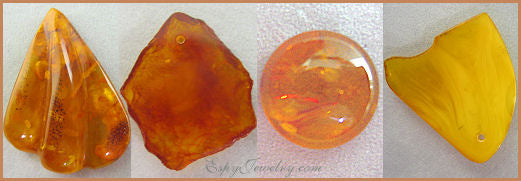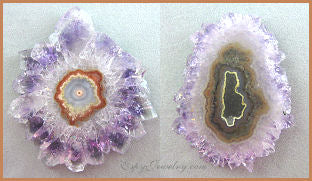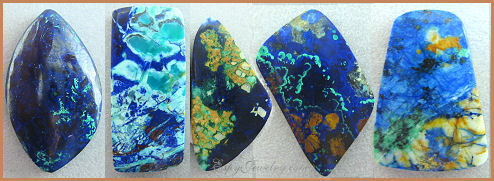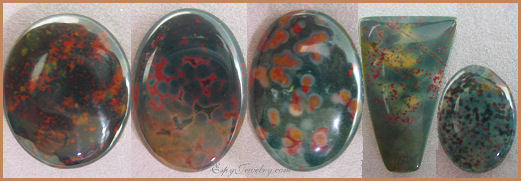Cabs A-B
Cabochons Index by Name
A B C D E F G H I J K L M N O P Q R S T U-V W X-Y-Z
Agate- Mohs 7
Agate is a subset of chalcedony quartz. It comes in many colors and patterns, including plumes, bands, and inclusions. Some popular types include crazy lace agate, burro creek agate, amethyst sage agate, plume agate, and moss agate.
Agatized
Agatized refers to a fossilization process by which the organic material is replaced by chalcedony quartz.
Amazonite - Mohs 6

Amazonite is a light green to blue-green variety of microcline feldspar. Although you can find stones that are just green, you more often see white or grayish white striations in it that are probably other types of feldspars. These striated stones may show a play of light that glides across the surface, similar to a moonstone. It is found many places around the world.
There are a variety of metaphysical properties associated with amazonite, but one of note is that amazonite is supposed to makes married life happier.
In the pictures above, although the camera did not capture it, the heart has a play of light that glides around the stone pretty much any way you hold it. The middle two pictures are the same stone, just turned end for end. In the first orientation you do not see any play of light as you move the stone. In the second picture, as you lift the left edge up, you do see the color play and the stone loses its predominant green in favor of brilliant reflections of white. The camera caught a little bit of this that shows as roughness in the image. The third stone is much bluer in color and there is no color play at all.
Amber - Mohs 2 - 2.5

Amber is fossilized pine tree resin. It is usually a golden yellow to a golden orange, but it is found in other colors. It can be transparent or opaque, clear or bubbly, and it can have things trapped in it, most notably insects.
Amber can dehydrate, causing cracking and color changes.
Amethyst Stalactite Slice

It’s hard to appreciate how long it took an amethyst stalactite to form so that it could be removed and sliced for our appreciation. The slices that come from these stalactites are quite unusual.
Stalactites form over time as mineral rich water drips from the roof of a cave. Slowly but surely these minerals precipitate out and build the diameter of the stalactite. Over time the minerals being brought by the ground water may change, showing up as color changes in the concentric rings that form around the outside of the stalactite. Most of these start out with an agate center that then builds amethyst crystals around the exterior diameter. Amethyst is purple quartz and you normally see a combination of both the clear and purple crystals.
Ammonites & Ammolite
See Ammonites & Ammolite.
Amphibole
Any of a group of common rock-forming magnesium-iron silicate minerals. They are commonly green to black, but may be colorless, white, yellow, blue, or brown. The commonest form is hornblende; other species include anthophyllite, cummingtonite, tremolite, actinolite, riebeckite, and glaucophane. A variety of jade, called nephrite, consists of actinolite in a finely fibrous form. Some highly fibrous forms are collectively called asbestos.
Anyolite
See Ruby-Zoisite.
Aragonite - Mohs - 3.5-4

Aragonite is named for Aragon, Spain, where it was first discovered. It is a calcium carbonate and is found in a variety of colors, from white to pastel shades of tans, browns, reds, yellows, oranges, greens, and blues.
You see aragonite more in specimens than in cabochons, but I love the blue stones and I buy them when I can find them. The stones pictured above get their color from copper. They all came from either Mexico or Peru.
In addition to being found as an inorganic mineral, aragonite is created by mollusks. It is a major contributor to the color plays of ammolite, paua, pearls, and other nacre or mother of pearl substances.
Asbestos
Asbestos is not a mineralogical term but rather a commercial designation for mineral products that possess high tensile strength, flexibility, resistance to chemical and thermal degradation, high electrical resistance, and that can be woven.
Commercially, asbestos refers to the fibrous form of any of a six silicate minerals within the serpentine and amphibole groups. Chrysotile asbestos (white) is a form of serpentine. Varieties of amphibole asbestos are amosite (brown), crocidolite (blue asbestos form of riebeckite), tremolite, actionolite, and anthophyllite. In addition to these six, there are other amphibole minerals that also form long, thin fibrous crystals and get called asbestiforms. These include richterite and torendrikite (dark blue intermediate between richterite and glaucophane).
Asbestos and asbesiforms are often found comprising veins in other rock.
Azurite - Mohs - 3.5

Azurite is a deep blue mineral that gets its color from copper. It doesn’t like to be heated (you can lose the color) so wire wrap is a great way to set it. It is often found intermixed with other copper minerals like malachite and cuprite.
Bertrandite
MINERAL: a colorless, white, yellow, or light pink mineral that contains beryllium.
LAPIDARY STONE: a purple stone from Utah. See Tiffany Stone.
Bloodstone - Mohs - 7

Plasma is dark green, opaque chalcedony quartz with the color coming from chlorite.
Bloodstone is plasma with red spots of iron oxide.
Most references say that to be called bloodstone, the spots can only be red. If the spots are yellow or white or missing, then it should be called plasma.
In actual practice, I have never seen anything called plasma for sale. While some stones sold as bloodstone only have red spots, many others have both red and yellow in the same stone. I’m actually partial to the ones with yellow in them because the yellow tends to brighten up the stone a bit.
Bornite
See Peacock Ore.
Boulder Opal
See Opal.
Bowenite
See Serpentine.
Cabochons Index by Name
A B C D E F G H I J K L M N O P Q R S T U-V W X-Y-Z
A B C D E F G H I J K L M N O P Q R S T U-V W X-Y-Z
A
Agate- Mohs 7
Agate is a subset of chalcedony quartz. It comes in many colors and patterns, including plumes, bands, and inclusions. Some popular types include crazy lace agate, burro creek agate, amethyst sage agate, plume agate, and moss agate.
Agatized
Agatized refers to a fossilization process by which the organic material is replaced by chalcedony quartz.
Amazonite - Mohs 6

Amazonite is a light green to blue-green variety of microcline feldspar. Although you can find stones that are just green, you more often see white or grayish white striations in it that are probably other types of feldspars. These striated stones may show a play of light that glides across the surface, similar to a moonstone. It is found many places around the world.
There are a variety of metaphysical properties associated with amazonite, but one of note is that amazonite is supposed to makes married life happier.
In the pictures above, although the camera did not capture it, the heart has a play of light that glides around the stone pretty much any way you hold it. The middle two pictures are the same stone, just turned end for end. In the first orientation you do not see any play of light as you move the stone. In the second picture, as you lift the left edge up, you do see the color play and the stone loses its predominant green in favor of brilliant reflections of white. The camera caught a little bit of this that shows as roughness in the image. The third stone is much bluer in color and there is no color play at all.
Amber - Mohs 2 - 2.5

Amber is fossilized pine tree resin. It is usually a golden yellow to a golden orange, but it is found in other colors. It can be transparent or opaque, clear or bubbly, and it can have things trapped in it, most notably insects.
Amber can dehydrate, causing cracking and color changes.
Amethyst Stalactite Slice

It’s hard to appreciate how long it took an amethyst stalactite to form so that it could be removed and sliced for our appreciation. The slices that come from these stalactites are quite unusual.
Stalactites form over time as mineral rich water drips from the roof of a cave. Slowly but surely these minerals precipitate out and build the diameter of the stalactite. Over time the minerals being brought by the ground water may change, showing up as color changes in the concentric rings that form around the outside of the stalactite. Most of these start out with an agate center that then builds amethyst crystals around the exterior diameter. Amethyst is purple quartz and you normally see a combination of both the clear and purple crystals.
Ammonites & Ammolite
See Ammonites & Ammolite.
Amphibole
Any of a group of common rock-forming magnesium-iron silicate minerals. They are commonly green to black, but may be colorless, white, yellow, blue, or brown. The commonest form is hornblende; other species include anthophyllite, cummingtonite, tremolite, actinolite, riebeckite, and glaucophane. A variety of jade, called nephrite, consists of actinolite in a finely fibrous form. Some highly fibrous forms are collectively called asbestos.
Anyolite
See Ruby-Zoisite.
Aragonite - Mohs - 3.5-4

Aragonite is named for Aragon, Spain, where it was first discovered. It is a calcium carbonate and is found in a variety of colors, from white to pastel shades of tans, browns, reds, yellows, oranges, greens, and blues.
You see aragonite more in specimens than in cabochons, but I love the blue stones and I buy them when I can find them. The stones pictured above get their color from copper. They all came from either Mexico or Peru.
In addition to being found as an inorganic mineral, aragonite is created by mollusks. It is a major contributor to the color plays of ammolite, paua, pearls, and other nacre or mother of pearl substances.
Asbestos
Asbestos is not a mineralogical term but rather a commercial designation for mineral products that possess high tensile strength, flexibility, resistance to chemical and thermal degradation, high electrical resistance, and that can be woven.
Commercially, asbestos refers to the fibrous form of any of a six silicate minerals within the serpentine and amphibole groups. Chrysotile asbestos (white) is a form of serpentine. Varieties of amphibole asbestos are amosite (brown), crocidolite (blue asbestos form of riebeckite), tremolite, actionolite, and anthophyllite. In addition to these six, there are other amphibole minerals that also form long, thin fibrous crystals and get called asbestiforms. These include richterite and torendrikite (dark blue intermediate between richterite and glaucophane).
Asbestos and asbesiforms are often found comprising veins in other rock.
Azurite - Mohs - 3.5

Azurite is a deep blue mineral that gets its color from copper. It doesn’t like to be heated (you can lose the color) so wire wrap is a great way to set it. It is often found intermixed with other copper minerals like malachite and cuprite.
B
Bertrandite
MINERAL: a colorless, white, yellow, or light pink mineral that contains beryllium.
LAPIDARY STONE: a purple stone from Utah. See Tiffany Stone.
Bloodstone - Mohs - 7

Plasma is dark green, opaque chalcedony quartz with the color coming from chlorite.
Bloodstone is plasma with red spots of iron oxide.
Most references say that to be called bloodstone, the spots can only be red. If the spots are yellow or white or missing, then it should be called plasma.
In actual practice, I have never seen anything called plasma for sale. While some stones sold as bloodstone only have red spots, many others have both red and yellow in the same stone. I’m actually partial to the ones with yellow in them because the yellow tends to brighten up the stone a bit.
Bornite
See Peacock Ore.
Boulder Opal
See Opal.
Bowenite
See Serpentine.
Cabochons Index by Name
A B C D E F G H I J K L M N O P Q R S T U-V W X-Y-Z
 Unique, One-of-a-Kind Settings for Unique, One-of-a-Kind Stones
Unique, One-of-a-Kind Settings for Unique, One-of-a-Kind Stones